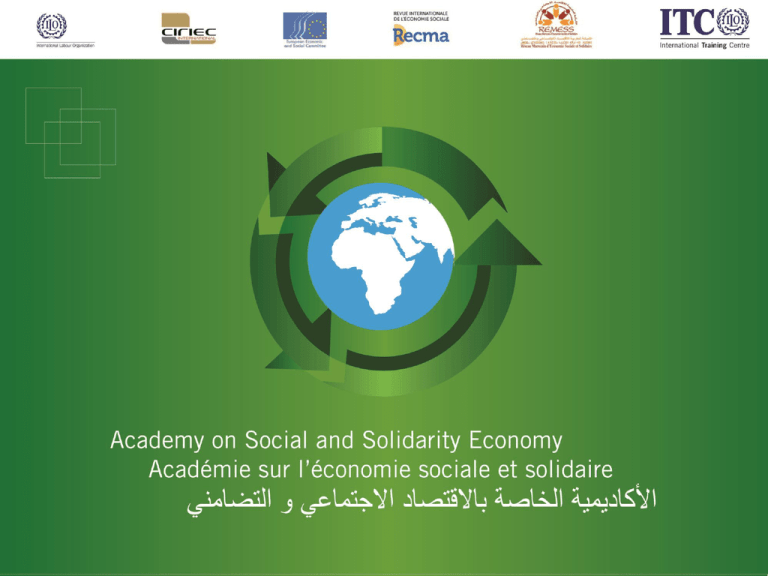The Case of Kenya - English (SSEA2013)
advertisement

YOUTH ENTREPRENEURS AND THE SOCIAL AND SOLIDARITY ECONOMY: THE CASE OF KENYA By Fredrick Wanyama, School of Development & Strategic Studies, Maseno University, KENYA. INTRODUCTION • Large proportion of the youth is unemployed – 70% of the unemployed in Kenya are youth • Employment interventions have targeted “nonconventional” opportunities in areas like informal sector for self-employment • The social and solidarity economy a key promoter of self-employment • Comparatively smaller proportion of the youth participate in social and solidarity economy • Less participation of youth in SSE attributed to: – The preoccupation with getting “white-collar” jobs – Lack of appreciation of the power of collective action in solving socio-economic problems – Dependence on parents, siblings and spouses – Lack of resources to contribute to SSE activities – Single youth don’t face household challenges • Given the little presence of the youth in SSE, can the SSE approach create employment for the youth? • Purpose: • To illustrate how the SSE financing modalities have enabled a governmentsponsored Fund to create jobs for the youth in Kenya YOUTH ENTERPRISE DEVELOPMENT FUND (YEDF) • The Kenya government established the YEDF in 2006 – A revolving fund for supporting the youth to start and develop enterprises for job creation • YEDF uses financing modalities of the SSE: – Lending to groups rather than individuals to build solidarity among the youth – Individual borrowers have to belong to groups – Lending through financial intermediaries that are part of the SSE, e.g. SACCOs – Spearheading the formation of youth SACCOs – Creating Credit Guarantee Schemes for young entrepreneurs YEDF AND YOUTH EMPLOYMENT • YEDF started with KES 1 billion (US$. 11.7 million) • Government contribution is as follows: Financial Year Amount (in KES) 2006/2007 1,000,000,000 2007/2008 725,000,000 2008/2009 499,914,170 2009/2010 540,750,000 2010/2011 550,000,000 TOTAL 3,315,664,170 • YEDF value now stands at over KES 6 billion (US$. 70.6 million) • About half of the fund value is from repayment of loans borrowed by the youth – youth enterprises picking up? • Funds disbursed through three schemes: – Constituency Youth Enterprise Scheme (C-YES) – Easy Youth Enterprise Scheme (E-YES) – Financial Intermediaries • A total of KES 5.96 billion has been advanced to youth entrepreneurs through these schemes THE C-YES • Youth group mandatory for access to C-YES • The youth group is expected to be: – – – – Registered for at least three months Based in the constituency Proposing/undertaking a business activity Operating an active bank account • By September 2011: – Had advanced KES 545.3 million to 12,407 youth group enterprises – Exact number of jobs created not available, but estimated at a minimum of 40,000 self-employed jobs • It has motivated the youth to embrace mutual support to seek financial services to do business E-YES • Builds on the gains of the C-YES • Targets individual youth entrepreneurs within groups that successfully repay C-YES loans • Groups that successfully repay C-YES loans can also borrow from E-YES • Individuals can borrow up to KES 100,000 and groups up to KES 400,000 • By September 2011: – KES 54.2 million advanced to 2,111 entrepreneurs – 2,111 self-employed jobs created for the youth FINANCIAL INTERMEDIARIES • On-lending to youth-owned enterprises through financial institutions like banks, SACCOs, and micro finance institutions • YEDF gives term loans to intermediaries at 1% interest • Intermediaries on-lend to youth entrepreneurs at 8% interest • Loanable amount depend on the nature of business, but does not exceed KES. 1 million • YEDF has partnered with 37 intermediaries that onlend to the youth • By September 2011: KES 4.6 billion disbursed GENDER ENTREPRENEURS AMOUNT (KES) Male 65,103 2,657,189,396 Female 64,281 1,957,864,738 TOTAL 129,385 4,615,054,135 • 129,385 jobs directly created for both male and female youth entrepreneurs • 24 youth SACCOs formed to be intermediaries • In total, YEDF has created over 300,000 jobs CHALLENGES ENCOUNTERED • Inadequate disbursement and repayment infrastructures in remote rural areas: – Difficulties in reaching the youth – Youth fail to repay loans in time • The youth lack skills for managing their enterprises • Some members of groups leave to take up college and wage employment opportunities • Insufficient policy and legal framework to support growth and sustainability of youth enterprises CONCLUSION • The SSE approach has enabled YEDF to create over 300,000 jobs for the youth in 5 years • With 4 million youth unemployed, YEDF might have helped just 9% of the unemployed youth to find jobs • Though modest, the contribution is significant • What has accounted for the relative success? – The availability of capital from which to borrow – Entrepreneurship training & business development services – Solidarity and mutuality among youth as a condition LESSONS FOR SSEO • Solidarity and mutuality embedded in SSE is clearly an asset for youth entrepreneurship • Availability of a larger capital base is critical for youth enterprise development. SSEs should strengthen their financing mechanisms • Improved financing need to be accompanied by entrepreneurship training and business development services • With these remedies, SSE has the potential to create jobs for the youth QUESTIONS • What is the experience with youth participation in the SSE in your country? • What should be done to improve youth participation in SSE? • How can the SSE improve its capital base to support youth entrepreneurs? • Are the youth ready to do business? • What are the challenges facing youth entrepreneurs in your country?











